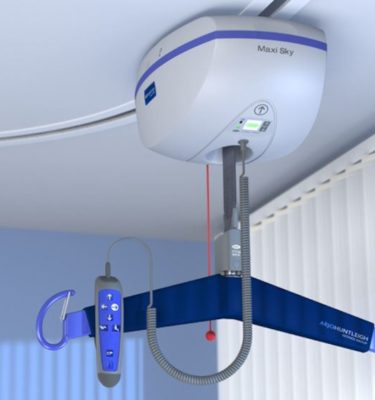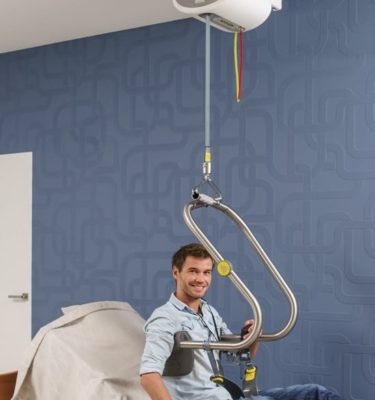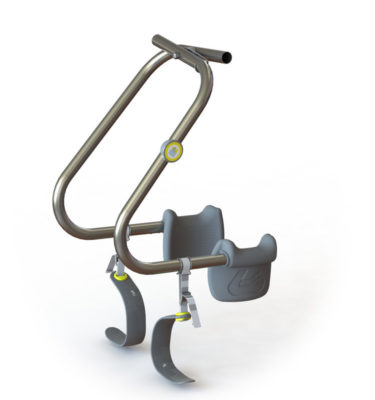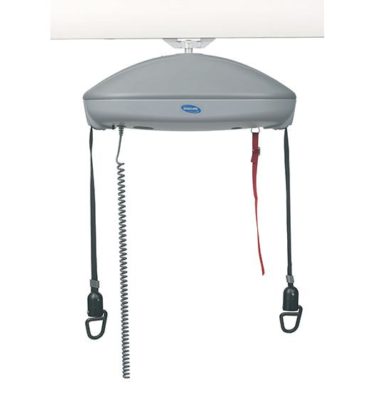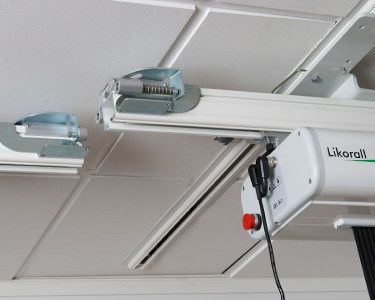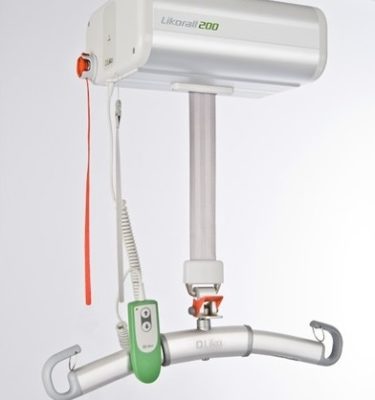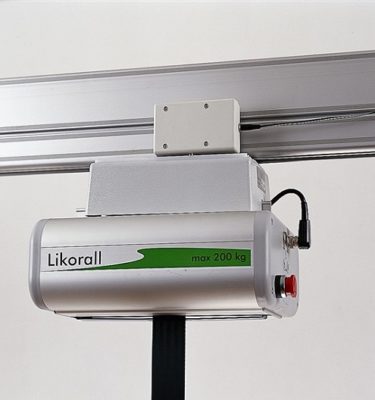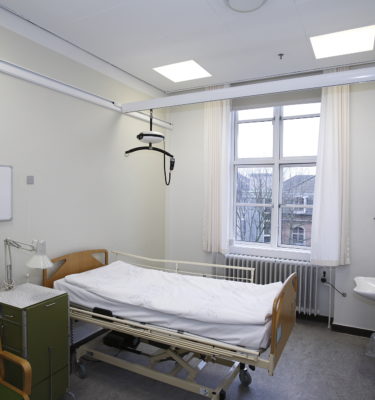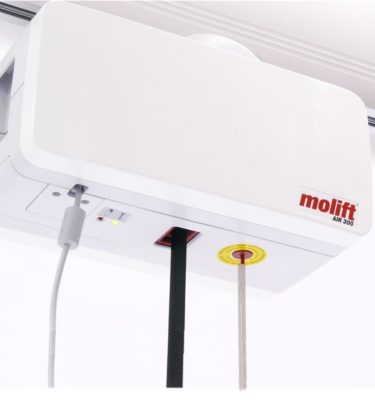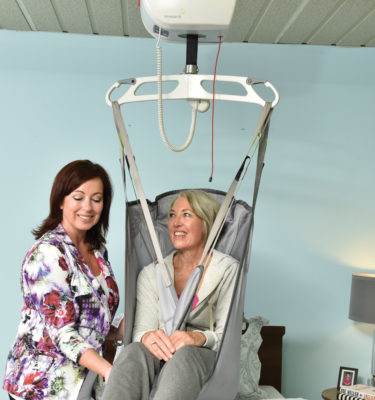Ceiling hoists can help you move more easily and safely throughout your property if you’re disabled, elderly or have reduced mobility. Dolphin Mobility in Surrey stocks all types of hoists for you to choose from. Our ceiling mounted hoists use up no floor space. Where appropriate they can be operated by users independently. They can travel from room to room. Some models can be easily detached for use on tracking installed in other rooms. We can supply and install portable and fixed overhead hoists for you anywhere throughout Surrey, London and the home counties.

Guide to Ceiling Hoists
Planning a ceiling hoist installation
Planning a ceiling hoist installation can be complicated. There is a lot to think about. This is why it is important to speak to a professional before any work is started. The first thing to consider is what type of transfer is required? If you just need to get a person in and out of bed, this should be relatively simple. The following is a very brief list of things to keep in mind:
- Bed to chair transfer
- Multiple transfer points in one room
- Room to room transfers
- Door headers
- Lights that hang down from the ceiling
- Sprinkler systems and smoke alarms
- Straight track or curved track?
Fitting a Ceiling Lift
Ceiling Lifts must be installed by a professional. It is extremely dangerous to try and fit one without any experience. Once installed they must be fully load tested before use. Load testing must be carried out periodically according to how often the hoist is used. A huge range of options are available to make sure the hoist will work for the person being hoisted and their carer. Our hoist specialists can look at your room or plans and advise on potential issues.
- Can the structure of the building support the load?
- Do LOLER regulations apply to you?
- Are your hoist installers qualified and experienced?
Installing ceiling hoists
In general, most buildings can accommodate a ceiling mounted hoist. At Dolphin Mobility, our team of engineers use a variety of fixings to secure our hoists. The following applications are commonplace.
- Concrete ceilings
- Steel webbed joists
- Cathedral/sloping ceilings
- Steel and timber I beams
- Timber joists
- Suspended ceilings
- Pitched roofs
Get on the right track
You can choose from many different track layouts for your ceiling lift. The easiest and most cost-effective tracking to install is straight tracking. However, adding curves and bends will increase room coverage and lifting and repositioning flexibility. Our XY hoist track system is a popular option because it allows for full room coverage. For more details, don’t hesitate to get in touch. We provide:
- Straight tracking
- Straight track with 45 or 90 degree bends
- Room to room track systems
- XY or H frame tracking systems
- Turntables
- Y Junction exchangers
- Wall mounting
- Semi-permanent tracking

How much do ceiling hoists cost?
The cost of a ceiling hoist system is determined by many variables. There are so many things to consider that it can be quite daunting if you are not familiar with hoist systems. For this reason it is often very difficult to give you an accurate price.
Straight Ceiling Lift Prices
Will the track be straight? Or will it need to have bends? A straight rail will always be cheaper. This is because they are much easier to fit. Track length is the easiest variable to quantify. The shorter the track, the cheaper the hoist will be. Therefore the material cost is lower and there will be less fixings required. Although the fixings are not usually that expensive, the labour for fitting them can add a lot to the cost.
A 3-metre straight track hoist fixed direct to timber joists or a concrete ceiling is usually around £2,000.
XY Ceiling Hoist Prices
XY hoists are used when there are multiple transfer points in one room. We often install them in bathrooms and changing places facilities. Sometimes they are referred to as H Frame hoists. XY hoists are generally easier to install than fitting tracks with bends, junctions or turntables. For this reason they are usually cheaper.
A simple 3-metre x 3-metre XY system would cost between £2,500 and £3,000.
Manual traverse or powered traverse?
A manual traverse hoist requires the carer to move the person along the track manually. Many carers prefer this as they find it easier to position the service user. The manual version is often called a 2-way hoist. Powered traverse lifts would be known as a 4-way hoist.
The powered option would usually add at least £100 to the price.
Lifting Capacity
The weight of the person being lifted has to be considered. If the user is less than 200 kg then it shouldn’t effect the price. The exception would be if we’re fixing to joists smaller than 6 x 2″ (140 x 38mm). That size of joist would mean the lifting capacity would have to be downrated. Alternatively the joists would need to be doubled up.
Suspended Ceiling
If there is a suspended ceiling this make can make a big difference to the price. We would need site information before we could price this accurately. A void of less than 10cm would not greatly effect the price. A bigger void may mean that we need to use lateral bracing. This type of bracing is needed to make the track stable. Without it the tracks could from from side to side. This would be usnsettling for the user and potentially dangerous. With a suspended ceiling there is a higher risk of services or insulation getting in the way of where we need to make fixings. Often we will need to look at alternative methods of fixing.
Wall Brackets
If the walls are of a solid brick contruction then wall brackets could be the simplest and cheapest way of mounting the hoist. If the wall is load bearing then you should be able to use wall brackets. They are only suitable for straight or XY hoist installs. If the track needs a curve then this must be supported from above.
A 3 metre ceiling track hoist fitted using wall brackets could be as little as £1800.
Wall Posts
Wall posts would be used when the wall is not load bearing. For example, if you have stud walls or partition walls. Most posts are fitted vertically. This has the effect of transferring the load to the floor. All manufacturers have a slightly different version but the principle remains the same. Fixing to the wall is an increasingly popular option.
A 3 metre hoist fixed using vertical wall posts would start from around £2200.
Ceiling Hoist Features
There are a number of features and accessories that can help make an overhead hoist easier to use. Some come as standard, others have to be specified. Our expert surveyors can advise on the most suitable configuration for your needs.
- User programmable features
- Emergency stop and lowering
- Battery and charging system
- Return to charge feature
- Wireless remote controls available
- Power sharing function for turntables, gates and exchangers
- 2 way or 4 way powered lifts available
- Body support frame for independent transfers
Self Hoisting
Most people will require assistance to use a ceiling lift. However with the right equipment a significant number of wheelchairs users can hoist independently. Self-hoisting can dramatically reduce care costs. To the extent that the hoist can pay for itself very quickly.
- Slings should not be used
- Infra red or wireless controls are highly preferable
- You must have a means of calling for assistance in the event of an emergency
- Emergency lowering should be mechanical in case of electrical failure
- The track system should be as simple as possible
- A powered traverse motor is essential
- Controls should be kept in a neck lanyard so there is no chance of them being dropped
Our Ceiling Hoists
-
Arjo Maxi Sky 2 Ceiling Hoist
Read more -
Handi-Move 2800 Ceiling Hoist
Read more -
Handi-Move Updated Body Support System
Read more -
HandiMove Wall Lift Hoist
Read more -
Invacare Robin Ceiling Hoists
Read more -
Liko Ceiling Hoists
Read more -
Liko Hoist Tracking and Rail Options
Read more -
Liko Multirall 200 Ceiling Hoist
Read more -
Likorall 200 Overhead Hoists
Read more -
Likorall 242 Overhead Hoists
Read more -
Luna Ceiling Hoists from Ergolet
Read more -
Maxi Sky 1000 Bariatric Hoist
Read more -
Molift Air Ceiling Hoist
Read more -
Monarch Ceiling Hoist
Read more
Enquiry Form
We stock a range of stairlifts, steplifts, mobility aids and all types of hoists. For more details, call
0800 9800 126

